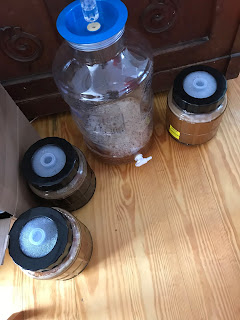Here is what I did: I produced a full, 5-gallon size batch of what I will call the "base wort" for this experiment. My base wort was a ~1.050 SG (fermenting out to 4.5-5% ABV) amber colored mash bearing a lot of similarity to an American amber ale or an English Bitter. In true autumnal fashion, the fermentables in the mash included the roasted meat of a decent sized culinary pumpkin squash. For the brewers out there, here is what went in that mash:
- 7 lbs Maris Otter Malt (my all-time favorite base malt)
- 1 lbs 60°L Crystal Malt (caramel, baked cookie notes)
- 1 lbs dark (20°L) Munich Malt (for chewy, biscuity notes)
- 1 lbs flaked unmalted wheat (creaminess, mouthfeel, head retention)
- 3-4 lbs meat of one whole roasted pumpkin squash
And here is how one makes four different pumpkin beers from one base pumpkin beer:
- Pumpkin Spice Latte Stout
- Transferred ~1.5 gallons into another kettle
- Steeped 4 oz roasted unmalted barley for 30 minutes to add color and roastiness
- this is similar to what you would do if you were brewing an extract beer
- I did this while bringing the other two batches to a boil to offset the finish times
- Added ~3 oz lactose (milk sugar) to beer--this is the "cream" or "milk" in the pumpkin spice latte and will add some residual sweetness and increased body/mouthfeel
- Added slightly more bittering hops than other pumpkin beers
- Fermented with Wyeast
1469 West Yorkshire ale1214 Belgian Abbey - In my tired state, I accidentally pitched Belgian yeast into this beer instead of the more neutral English yeast strain. This won't "ruin" the beer but it will add a fruity/spicy Belgian quality that I wasn't exactly looking for in a milk stout with so much else going on
- Fruity and spicy yeast characteristics might actually compliment a pumpkin spice beer rather nicely, as long as they don't muddy things up...I'll try to keep the beer nice and cool so those characteristics are subdued and we'll see how it goes at tasting time
- Coffee and pie spices added to beer via "spice potion" at bottling time
- Pumpkin Braggot
- Transferred ~1.5 gallons into yet another kettle
- Added a small amount of bittering hops for very low bitterness but still some balance
- Added 1 pound of wildflower honey to batch after cooling slightly
- This is a very large percentage of honey (more than 30%, less than 50%) in the fermentables, which means there is "too much honey" for it to be considered beer, yet not quite enough for it to be considered mead, hence braggot
- Honey has a lot of simple sugars, so it will ferment out very clean and dry but add lots of delicate floral characteristics to the beer
- Fermented with Wyeast
1214 Belgian Abbey1469 West Yorkshire ale - This was the other beer that got mixed up, but I was on the fence about yeast selection for this one anyway. Wy 1469 only has an alcohol tolerance of 9%, but the braggot should be closer to 8%
- Because there will be fewer spice/fruit notes from the yeast, I will be more inclined to add some spices to this beer at bottling now, especially some vanilla and nutmeg...we'll see how she tastes
- Punkass Pie Ale & Saison Potiron:
- Remaining ~3 gallons of beer left in large kettle
- Bittering hops added to the tune of ~25 IBU (enough for balance without astringency)
- Added 3 oz dark brown sugar to wort--this will not add sweetness but actually clean dryness and a hint of molasses character, and Belgian yeasts like some simple sugar
- Saison Potiron:
- Fermented with Wyeast 1214 Belgian Abbey ale
- That's it--this beer's character will come from fruit and spice notes of the Belgian yeast along with some biscuity malt character and squashy pumpkin notes
- Punkass Pie Ale:
- Fermented with Wyeast 1469 West Yorkshire ale - beer should be very clear with not many notes from the yeast, with a some residual sweetness
- Pie spices added via spice potion at bottling
- Should taste like a pumpkin pie
This may seem like a crazy complicated list of how to make these different beers, but let me break it down more simply--we started with a base wort and only added these couple of distinguishing factors to each batch partition to make four wildly different brews:
- PSL Stout (most complicated): specialty grain, lactose, pie spices, coffee
- Braggot: honey
- Saison Potiron: brown sugar
- Punkass Pie: brown sugar, pie spices



